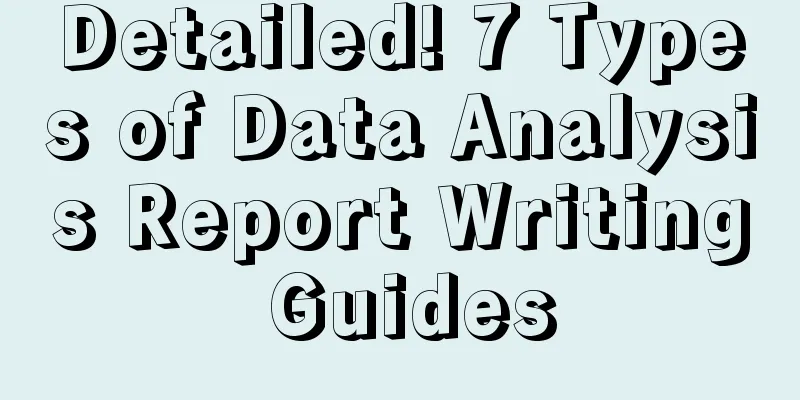Detailed! 7 Types of Data Analysis Report Writing Guides

"Why is my boss not satisfied with my data analysis report?!" is a question that bothers many students. In particular, sometimes the boss will complain that "the report is too detailed and needs to be focused." Sometimes the boss will complain that "it is too rough and needs to be more detailed." What is the scale and how to strike the right balance? The key point is: data analysis report is first of all a report, and it must have a clear report logic. As for the data, it just makes the report more credible and more real. So how many common logics are there in making reports? According to a person's familiarity with the content of the report, there are 7 types, which are introduced one by one as follows: 1. Introduction ReportAn introductory report is suitable for the first report to someone who does not know the situation. An introductory report generally adopts a general-specific structure and is introduced from several angles. For example, it introduces the activities, some members, and product lines. At this time, the report framework is as shown in the figure below: Attention! Many reports to big bosses will start with an introductory report, because big bosses may not understand the business details, so you need to explain it clearly from several angles. At this time, the indicators must not be too detailed, otherwise you will be criticized for "not understanding" or "too detailed". 2. Monitoring ReportMonitoring reports are suitable for: providing business development trends to people who have a certain degree of understanding. The length of monitoring reports depends on the needs of the leaders. Some leaders like to be detailed, so the monitoring content is more, while some leaders like to focus on the key points, so the monitoring content is less, and only key indicators are retained. The key to monitoring reports is to explain the trend of indicators in conjunction with business actions. The most taboo in monitoring reports is to write them as a running account of numbers: this week, the year-on-year increase was x%, the month-on-month increase was y%, the time progress ratio was z%, and the KPI completion rate was xx%. People are confused and have no conclusions. When making monitoring reports, it is necessary to link the fluctuations of monitoring indicators with specific business actions to facilitate the readers to make judgments. 3. Exploratory ReportExploratory reports are suitable for: giving people who have a certain degree of understanding the next direction of action. Note! What is given here is a "hint" and a "suggestion", not a conclusion. Therefore, exploratory reports must have strong logic and explain the logical relationship between the data listed and the conclusions given. The final tips/suggestions are also based on solid data. There are many ways to use the logic of an exploratory report. The simplest one is: positive and negative example method.
Of course, the more examples you can give, the more complete the argument will be (as shown below) 4. Diagnostic ReportDiagnostic reports are suitable for: explaining the cause of the problem to people who already understand the problem. The simplest diagnostic method is structural analysis + indicator decomposition/funnel analysis, which points out that there is a problem in the XX link of the XX business. However, for a more in-depth diagnosis, more complex logic may be required, and even AB test/labeling group comparison may be combined to produce results. Therefore, diagnostic reports can be written in depth. If the current analysis is not in-depth, do not make a closing report, but rather a process report, listen to everyone's opinions, and then decide how to go deeper next. Note! Diagnostic reports are only useful for people who know the problem well! If a person does not understand the background of the problem, he should first make an introductory/monitoring report. Otherwise, after giving the report, people will often criticize him: "I don't understand!" "Why do we have to worry about this problem!!!" 5. Test reportTest reports are suitable for explaining test results to people who already understand the problem. Test reports are also only useful for people who understand the problem! If a person does not understand the background of the problem, he should first make an introduction/monitoring report. Otherwise, he will often be criticized after giving the report: "What's the point of going through so much trouble!" The structure of the test report itself is simple and clear:
The main reminder here is to not forget to explain what the problem is! Even if some tests are done because: "I have a good idea", "I saw my competitors do this", "I heard my boss say this", it is best to find a clear and quantifiable problem point/test goal. Otherwise, after the test is over, you will have to look at dozens of indicators to see the differences, and then you really can't write a report... 6. Predictive ReportTest reports are suitable for giving predictions about a problem to people who already know the problem. Pay special attention! When writing a prediction report, you must pay attention to the level and appetite of the audience in advance.
This must be sorted out in advance. Otherwise, when you are talking about forecast reports, you will often be stopped and scolded: "Your forecast does not meet business expectations!" "Your forecast does not consider important issues that the business cares about!" "Let me ask you, if XX happens, will your forecast still be accurate?!" VII. Evaluation ReportEvaluation reports are suitable for giving a comprehensive evaluation of the problem to people who already know the problem well. Note! Like predictive reports, the success or failure of evaluation reports is also determined by the level and appetite of the audience.
This must be sorted out in advance. Especially when the evaluation involves departmental interests, such as the results of major projects, such as product performance. It is best to get a feel for the audience's attitude before writing the report. If it involves departmental interests, tell everyone the evaluation method in advance, and discuss which indicators and reference standards are used in advance. In this way, everyone will accept the result. The most worrying thing is that there is no unified method in advance, and everyone will raise or lower the results afterwards, or even temporarily modify the goals. It is better not to write this evaluation report. Writing it will only make the data analyst lose his integrity. When making data reports, think clearly about:
In this way, the data report can hit the other party's pain points, answer their questions and reduce doubts. Some reports can be very complex and long. The longer the report, the more you need to think clearly about what the central idea is. Avoid laying out data without any meaning. Author: Down-to-earth Teacher Chen Source: WeChat public account "Down-to-earth Teacher Chen (ID: gh_abf29df6ada8)" |
>>: Thinking about making the brand bigger
Recommend
What does Shopee's free shipping promotion mean? How to understand it?
Many friends want to buy goods on the Shopee platf...
Revealed for the first time: What did Duolingo do to trap 500 million people?
In the digital age, language learning app Duolingo...
The golden age of high-end brands has arrived
In the current situation of consumption downgrade,...
Let’s talk about podcasts, a traffic depression
As the audience of podcasts expands, more and more...
How to solve the problem of Amazon's store closure? What are the methods?
Once a related situation occurs on Amazon, if ever...
User portraits are criticized as "useless"! How can we make them useful?
Why is the user portrait report you wrote useless?...
Will Amazon's express delivery service be closed during the Spring Festival? How can merchants prepare?
There are many rules that need to be followed on t...
AI is here, and the most panicked ones are Taobao models
After AI became popular, many people began to worr...
6 types of people who can definitely make money on TikTok!
Uncover the six types of people who make money on ...
62 brands spent 1.2 billion euros. Is the more expensive the Olympic marketing, the better?
Under the five Olympic rings, the battle for brand...
Why do young people not like to watch exquisite vlogs anymore?
Recently, the topic #Why I don't like watching...
Why is Amazon spending too much money on advertising but not getting any sales? What are the reasons?
There are many merchants opening stores on the Ama...
How does Amazon create variations? What is the method?
To open a store on Amazon, you must first understa...
Flying towards the future, meeting new potential - Feilaihui appeared at the 2024 APEC SME Cross-border E-commerce Summit
On March 26, as an ecological partner of DHgate.co...
What are the three methods of promoting new products on Amazon? What is the promotion rhythm of new products?
As a global e-commerce giant, Amazon launches tens...









